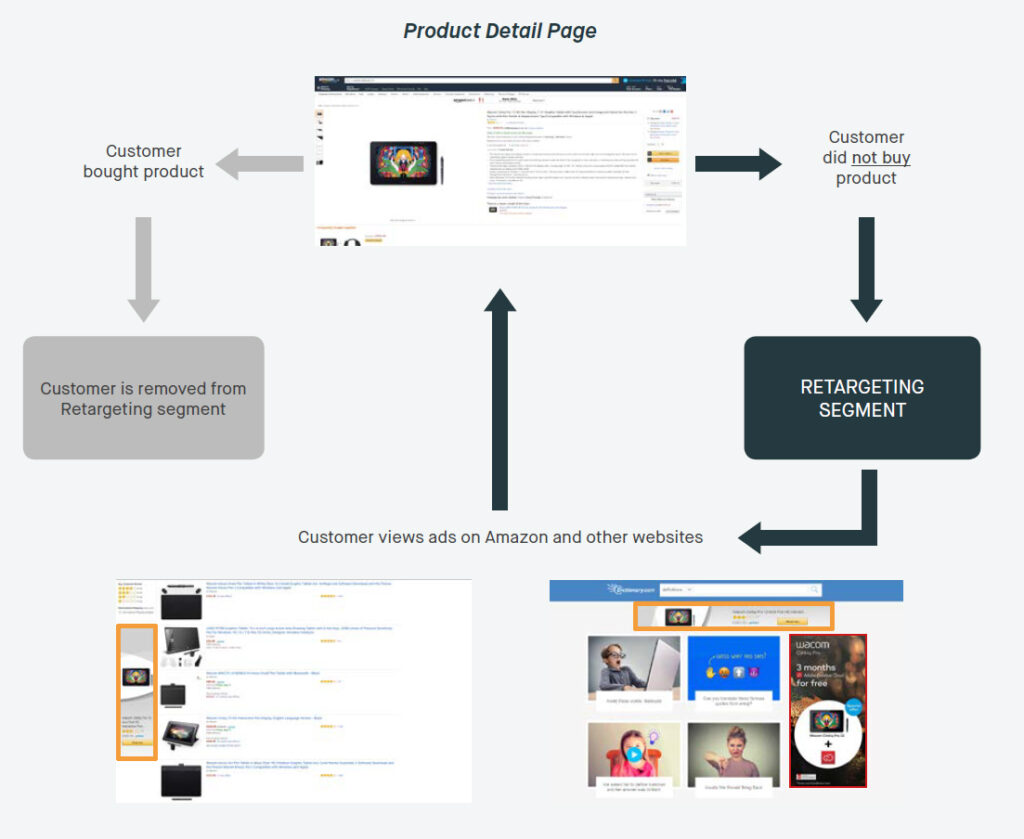
From among the powerful programmatic advertising options bundled within Amazon Advertising, retargeting with Amazon Demand Side Platform (DSP) has the most potential. When properly utilized, retargeting can lead to a significant increase in sales directly measurable through KPIs. In this article, we address these crucial points:
In general terms, retargeting is a form of programmatic advertising in which ads are shown to customers based on their past behavior, which on Amazon includes product searches, detail page views, and product purchases. Amazon categorizes these behaviors in retargeting audience segments, which then serve as the basis for campaign targeting. For instance, if a user searches for an item of your brand on Amazon, but does not purchase it directly, they will be reminded later: an ad for that product will be shown to them on both Amazon and third-party websites. The following scheme shows you how retargeting on Amazon works in practice.

How ASIN Retargeting works in DSP (Source: FACTOR-A/DEPT®)
By advertising with DSP, you can reach a worldwide audience of over 350 million users visiting large media outlets relevant to each region, on all devices.
Since retargeting is based on the customer’s existing interest and prior interaction, it is the most cost-effective option within programmatic marketing. Indeed, retargeting is the best tool for bringing external traffic back into the Amazon ecosystem and onto your product detail pages, while still maintaining high Return on Ad Spend (ROAS) and direct sales growth. As we’ll see, retargeting can increase ROAS dramatically. Coupled with Amazon’s authority on customer data analysis, no other advertising platform can deliver better, more precise targeting.
Furthermore, Amazon automatically excludes customers who have seen the ad and subsequently bought the product from the retargeting segment, because those who have already converted are not likely to buy the product again. Customers do not like seeing repeat ads for a product they have purchased recently. This feature is key for saving the money spent and impressions shown on those with a low to non-existent probability of converting. On the other hand, certain types of products (fast-moving consumer goods, especially) are suitable for retargeting directly after purchase to promote the Subscribe & Save rate.
Discover the possibilities of Amazon Advertising now by
downloading our DSP Whitepaper!
Now that you know why you should include retargeting Always On campaigns in your marketing measures, let’s take a look at what options there are and how you can implement them.
DSP offers you a range of retargeting segments:
Product Views segment targets users who viewed the product detail page of your item but have not purchased it within (up to) the last 90 days.
Product Purchases targets customers who bought your product for up to a year in the past and might be interested in buying it again.
Product Searches targets users who searched for a keyword related to your product in a given time frame. The keywords are selected by Amazon and cannot be viewed as of yet.
By targeting users within the SIM (Similarities) Product Views segment, you can reach consumers who have viewed the product detail pages of competing products and win them over for yourself. The similar products are also chosen automatically by the Amazon algorithm.
Brand Purchases and Brand Views correspond to Product Purchases and Views, but the buyer purchased any product from the brand’s portfolio.
A brand-new option is Competitor Conquesting (currently in beta) which works similarly to SIM Product Views. The added benefit is that you can choose which competitor products should be targeted in the segment.
Product Views are the most common retargeting segments, as they promise the highest ROAS. However, retargeting has other major uses such as cross and upselling. Imagine your customer just bought diapers. By running ads with the Brand Purchases segment, you can try and convince the customer to buy other baby products, such as baby wipes or creams, from you as well. With the Product Purchases segment, you can upsell a bigger pack of diapers with a higher price point. Since the ads are shown both on and off Amazon, they will be reminded everywhere they are on the internet.
There are several types of ads that can be used. Dynamic eCommerce Ads are the native advertising option for Amazon and are highly recommended for use in retargeting campaigns. A customer review can be added for ad customization to products with more than 15 reviews with an average of more than 3.5 stars. It is also possible to use standard banner ads and video ads, which are provided by the brand, but we recommend these types of ads for awareness campaigns rather than for retargeting since their main focus is not on conversion.
The following case study gives you a clear idea of what is possible with a strategically developed retargeting campaign.
The goal of our client Wacom who manufactures graphic tablets was to sustainably increase sales across their entire product range. In addition to their classic target groups, professional graphic designers, additional new segments were addressed with a variety of offerings. With the help of Amazon’s first-party customer data, customer groups such as manga fans or creative mothers were targeted.
First of all, we focused on placements on and off Amazon with the aim of attracting users to the products’ various detail pages. Video Ads with an average Detail Page View Rate (DPVR) of approx. 1.5% and a Click Through Rate (CTR) of 1.7% (FR) to 4.2% (UK) stood out across all countries. Cost-per-video completion was between 2 and 9 cents. By booking placements in the Amazon Christmas Store, customers who were looking for gifts for their loved ones were reached.
Since the overarching goal of the campaign was not brand awareness, but rather the direct promotion of sales, the focus was placed on the DPVR. Amazon’s native ad format, the Dynamic eCommerce Ad, was used for advertising. The ads were delivered in high frequency on mostly inexpensive placements ~$2.2 CPM (Cost Per Mille) outside of Amazon. In-Market segments were also used to target customers who were already familiar with graphic tablets or products in similar categories but had not yet purchased one.
A large-scale Sponsored Ads campaign was launched at the same time in order to fill the most important placements on the product search pages and pick up Amazon customers who were made aware of the product category through DSP. The Sponsored Ads campaigns themselves made an additional contribution to the campaign’s success with a ROAS of 12.

*The calculation of the ROAS comes from the products directly advertised in the campaign. The Total ROAS includes the ROAS and the Brand Halo Effect, the sales of further products from the manufacturer which can also be attributed to the marketing measures.
The results of this DSP setup can be seen above. Sales increased substantially across all countries. This case is an example of a judiciously coordinated and optimized campaign and is intended to demonstrate that the full potential of Amazon Advertising can only be exploited by combining the individual advertising formats and playing off their strengths.

Wacom is a global company based in Japan (Tokyo Stock Exchange: 6727), founded in 1983. Subsidiaries and local offices around the world ensure marketing and sales in over 150 countries. Wacom’s vision of bringing people and technology closer together through natural interface technologies has made the company the world’s leading manufacturer of interactive pen tablets and displays, digital pens and solutions for storing and processing digital signatures. The advanced technology of Wacom’s intuitive input devices has already been used to create some of the most exciting digital artwork, films, special effects and fashion and design projects in the world, and offers business and home designers the opportunity to express their personality through the use of this leading interface technology. Further information can be found at www.wacom.com.